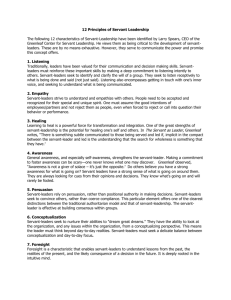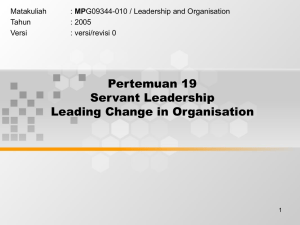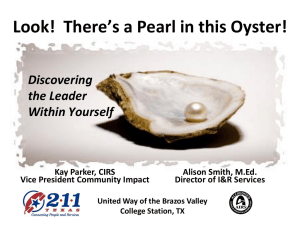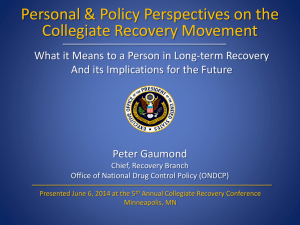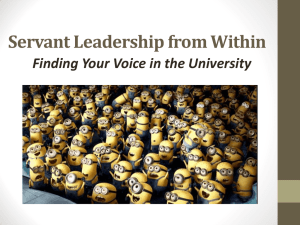Harmonizing Strategic Planning & Innovation 6/24/2014 Barbara Stewart – IT Director, Enterprise Architecture
advertisement
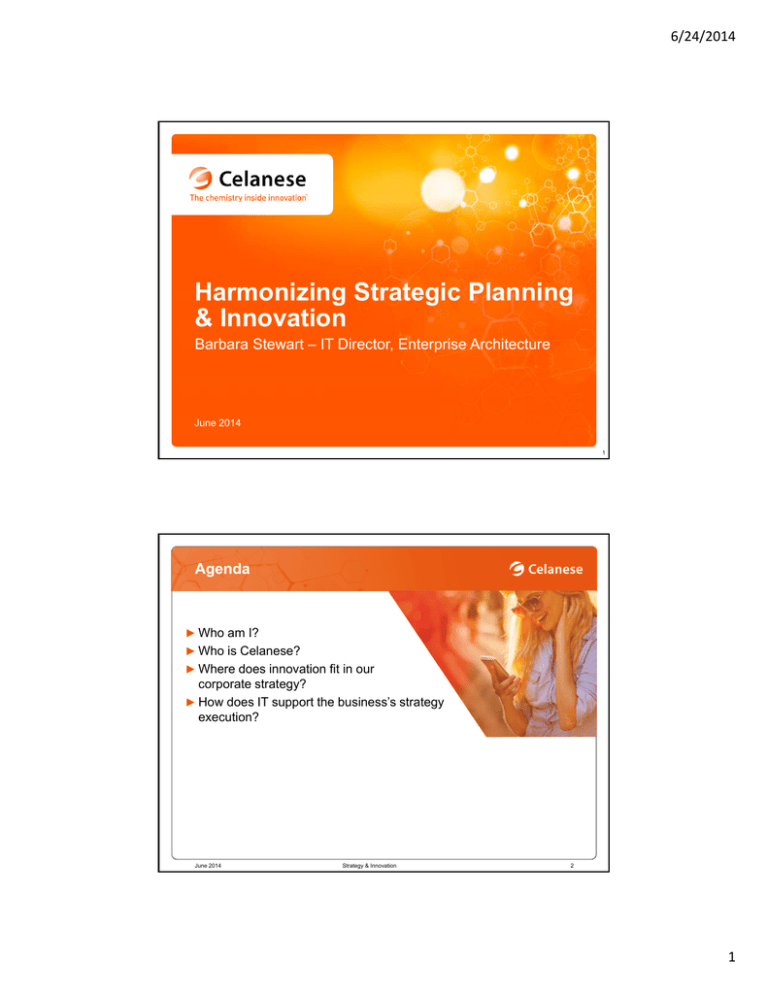
6/24/2014 Harmonizing Strategic Planning & Innovation Barbara Stewart – IT Director, Enterprise Architecture June 2014 1 Agenda ► Who am I? ► Who is Celanese? ► Where does innovation fit in our corporate strategy? ► How does IT support the business’s strategy execution? June 2014 Strategy & Innovation 2 1 6/24/2014 Barbara Stewart IT Director, Enterprise Architecture for Celanese Corporation Successful career with Celanese for 30 years ► Have extensive experience with several different businesses (Chemicals, Plastics, Corporate Shared Services) ► Current passion is mentoring ► Favorite experiences have involved addressing strategic ‒ in research, manufacturing and corporate technical challenges and functions leading our people to accomplish complex goals ‒ in local, regional, and global positions ‒ in both technical and management roles ‒ across infrastructure, operations, and ► Greatly enjoyed global roles applications including SAP that provided exposure to different cultures and the opportunity to interact with ► Accomplishments include: people throughout the US and ‒ Established the Enterprise Architecture in Asia, Europe, and Mexico function ‒ Established the Global Infrastructure and Operations function with the formation of ► New hobby = hiking (hiked across England; Scotland is Shared Services next) ‒ Sponsored Celanese’s ITIL adoption Barbara.Stewart@celanese.com 972 443-8284 June 2014 Strategy & Innovation 3 Celanese is a global technology and specialty materials company Advanced Engineered Materials Acetyl Intermediates 2013 Revenue: $6.5B Employees: 7,430 Manufacturing Locations: 27 Consumer Specialties Industrial Specialties June 2014 Strategy & Innovation ► Specialty thermoplastics used in automotive, electrical, electronics, more ► Acetic acid, vinyl acetate monomer, and additional intermediate chemistries ► Cellulose derivatives like acetate tow for filters ► Food ingredients including sweeteners, preservatives ► Emulsion polymers for paint, adhesives, nonwovens, carpets ► EVA polymers for flexible packaging, medical solutions 4 2 6/24/2014 Celanese’s major end-use segments Global presence and diverse applications in growth segments Paints & Coatings 11% Food & Beverage 2% Textiles 5% Automotive 15% Consumer & Industrial Adhesives 10% Consumer & Medical Applications 11% Construction 2% Industrial Performance Applications 7% Chemical Additives 7% Filter Media 19% Paper & Packaging 5% Other 5% Note: End-use percentages based on Celanese 2012 net sales with strategic affiliates proportional revenue and Celanese internal management estimates. Strategy & Innovation June 2014 5 Celanese’s global footprint Winona, MN Edmonton, AB Spondon, UK Meredosia, IL Geleen, Netherlands Boucherville, QC Perstorp, Sweden Roussillon, France Nantong, China Lanaken, Belgium KEP, Korea Auburn Hills, MI Clear Lake, TX Oberhausen, Germany Polyplastics Japan Florence, KY Sulzbach, Germany Dallas, TX Narrows, VA Budapest, Hungary Wilmington, NC Bay City, TX Al Jubail, SA Kaiserslautern, Germany Enoree, SC Bishop, TX Nanjing, China Shanghai, China Frankfurt, Germany Shelby, NC Tarragona, Spain Cangrejera, Mexico Kunming, China Polyplastics Taiwan Zhuhai,China Polyplastics Malaysia Singapore Ocotlan, Mexico Suzano, Brazil Joint Ventures Regional HQs June 2014 Strategy & Innovation 6 3 6/24/2014 Innovation & our corporate strategy Drivers of growth 2012 to 2013 Drivers of growth 2013 to 2014 ► Customer focused innovation ► Translating innovation to earnings Aiming for singles not home runs by leveraging 2 out of 3 of customer, technology, product - ► Focused gains in efficiencies ► Focused cost reductions June 2014 Strategy & Innovation 7 IT Strategic Planning Process JAN FEB MAR 1 Business/ Function Strategy Review Session with key business leaders APR MAY JUN 2 JUL AUG 3 Document Business Strategy Develop IT Strategy / Initiatives SEP OCT NOV DEC 4 IT Strategy Review and Sign Off by Business & IT leadership 3 year investment portfolio driven by business Large projects APPROVAL process Continuous investment prioritization and benefits realization (modeling Manufacturing capital expenditures process) The Investment Review Board (IRB) aligns and prioritizes IT investments with strategy to drive business value 4 6/24/2014 Investment Review Board purpose ► Manage projects to defined company strategy to maximize returns for IT investments ► Control / limit project spending ► Require hard business cases with post project reviews of benefits ► Align project priorities ► Review from a cross functional view to assure full support and alignment ► Challenge spending strategies (asset life, software spending cycles, user adoption, …) to assure we are making good spending choices ► Align on resource availability and talent required to drive projects Act as a device to drive down to spending and assure that approved projects delivered expected results June 2014 Strategy & Innovation 9 Investment Review Board process INPUTS ► IT Strategy ► Investment Projects ► Benefits Realization Plans + Results Key Functions ► OUTPUTS IRB (cross function leaders) ► Recommended IT Strategy / Policies ► Approved investments ► Benefits Realization Actions IT Strategy endorsement for approval by Executives Input and approval of corporate IT strategy and service proposals Leveraging reusable processes, data and technology assets ► IT investment prioritization all majorAPPROVAL IT investments acrossprocess geographies, locations, functions and business LargePrioritizes projects units Adjusts investment priorities / funding during the year based on new demand Establish policies on project funding working with IT ► Review of major projects benefits and value 5 6/24/2014 Investment Review Board criteria Criteria #1: Importance for Business / Function 1 Projects already have business cases with benefits statement and full financial costing. Ranking No strategic or not measurable 0 Not significant or aligned to Bus/Function strategy with some difficulty measuring impact 1 Important enabler to Business/Function strategy with measurable impact 3 Critical enabler to Business/Function strategy with measurable impact 9 Weight 30% Criteria #2: Quantified Benefits – Hard Benefits 2 The process enables business to filter out projects that are not currently feasible Payback > 4 years or Soft Payback only or No Payback 0 3 years < Payback <= 4 years 2 2 years < Payback <= 3 years 4 1 years < Payback <= 2 years 6 0.5 years < Payback <= 1 years 8 Payback <= 0.5 years 9 40% Criteria #3: Feasibility Significant risk to project delivery due to business/technical complexity or availability of business or IT resources 0 Major effort or project management of risk components 1 Medium Technical or Business process (CM) risk level that needs to be mitigated 3 No significant foreseeable risk and high adoption rate 9 Total 30% 5.4 June 2014 Strategy & Innovation 11 Approach to Enterprise Architecture Premise But ► EA is a strong, valuable tool ► Its value won’t be realized unless you can persuade folks to use it ► The EA team is a bit behind ► EA team members partner with the IT business solutions organization to work with the business the scenes and doesn’t face on strategy and projects the business alone ► Our small size forces us to set priorities and ► Our EA team is very small keeps us from working beyond our mission This model creates the need for an evolved set of competencies within EA, and in particular for competencies needed to serve AND lead June 2014 Strategy & Innovation 12 6 6/24/2014 BACKUP Slides June 2014 Strategy & Innovation 13 Language – working definitions Skills versus competencies ► Skills are often seen as an ability through knowledge, and quite often practice, to do something well ► Competency is more of an umbrella term that includes not only skills but also behaviors, knowledge, and experience Behaviors Skills Competency Knowledge Experience June 2014 Strategy & Innovation 14 7 6/24/2014 Competencies for Enterprise Architecture It is common to focus on and gauge skills, knowledge, and experience ► Skills ... Design, configuration, communications, analysis, strategizing, … ► Knowledge ... Business, applications, infrastructure, integration, … ► Experience ... Service delivery, major programs & projects, customer facing, … Behaviors Skills Competency But what about behaviors ? Knowledge Experience June 2014 Strategy & Innovation 15 Behaviors oriented to EA success Style Approach ► No personal agenda ‒ EA is not a path to glory ► Looks across boundaries ► Looks towards the future ► Leverages the power of many ► Influences based on Credibility + Insight ► Uses shared language listen AskAsk&&Listen ► Operates within the culture ► Focuses on results ► Flexible Negotiate Negotiate Consider Learn Path to value is humanistic Trust drives effectiveness Consolidate Integrate June 2014 Consolidate Consider Strategy & Innovation 16 8 6/24/2014 What is Servant Leadership? Robert K. Greenleaf Center for Servant Leadership Servant leadership is a philosophy and set of practices that enriches the lives of individuals, builds better organizations and ultimately creates a more just and caring world. While servant leadership is a timeless concept, the phrase “servant leadership” was coined by Robert K. Greenleaf in The Servant as Leader, an essay that he first published in 1970. In that essay, Greenleaf said: “The servant-leader is servant first… It begins with the natural feeling that one wants to serve, to serve first. Then conscious choice brings one to aspire to lead. That person is sharply different from one who is leader first, perhaps because of the need to assuage an unusual power drive or to acquire material possessions…The leader-first and the servant-first are two extreme types. Between them there are shadings and blends that are part of the infinite variety of human nature. “The difference manifests itself in the care taken by the servant-first to make sure that other people’s highest priority needs are being served. The best test, and difficult to administer, is: Do those served grow as persons? Do they, while being served, become healthier, wiser, freer, more autonomous, more likely themselves to become servants? And, what is the effect on the least privileged in society? Will they benefit or at least not be further deprived?“ A servant-leader focuses primarily on the growth and well-being of people and the communities to which they belong. While traditional leadership generally involves the accumulation and exercise of power by one at the “top of the pyramid,” servant leadership is different. The servant-leader shares power, puts the needs of others first and helps people develop and perform as highly as possible. June 2014 Strategy & Innovation 17 Ten Principles of Servant Leadership By Robert Greenleaf ► ► ► ► ► ► ► ► ► ► Listening - Traditionally, leaders have been valued for their communication and decision making skills. Servant-leaders must reinforce these important skills by making a deep commitment to listening intently to others. Servant-leaders seek to identify and clarify the will of a group. They seek to listen receptively to what is being said (and not said). Listening also encompasses getting in touch with one's inner voice, and seeking to understand what one's body, spirit, and mind are communicating. Empathy - Servant-leaders strive to understand and empathize with others. People need to be accepted and recognized for their special and unique spirit. One must assume the good intentions of coworkers and not reject them as people, even when forced to reject their behavior or performance. Healing - Learning to heal is a powerful force for transformation and integration. One of the great strengths of servant-leadership is the potential for healing one's self and others. In "The Servant as Leader", Greenleaf writes, "There is something subtle communicated to one who is being served and led if, implicit in the compact between the servant-leader and led is the understanding that the search for wholeness is something that they have." Awareness - General awareness, and especially self-awareness, strengthens the servant-leader. Making a commitment to foster awareness can be scary--one never knows that one may discover! As Greenleaf observed, "Awareness is not a giver of solace - it's just the opposite. It disturbed. They are not seekers of solace. They have their own inner security." Persuasion - Servant-leaders rely on persuasion, rather than positional authority in making decisions. Servant-leaders seek to convince others, rather than coerce compliance. This particular element offers one of the clearest distinctions between the traditional authoritarian model and that of servant-leadership. The servant-leader is effective at building consensus within groups. Conceptualization - Servant-leaders seek to nurture their abilities to "dream great dreams." The ability to look at a problem (or an organization) from a conceptualizing perspective means that one must think beyond day-to-day realities. Servant-leaders must seek a delicate balance between conceptualization and day-to-day focus. Foresight - Foresight is a characteristic that enables servant-leaders to understand lessons from the past, the realities of the present, and the likely consequence of a decision in the future. It is deeply rooted in the intuitive mind. Stewardship - Robert Greenleaf's view of all institutions was one in which CEO's, staff, directors, and trustees all play significance roles in holding their institutions in trust for the great good of society. Commitment to the Growth of People - Servant-leaders believe that people have an intrinsic value beyond their tangible contributions as workers. As such, servant-leaders are deeply committed to a personal, professional, and spiritual growth of each and every individual within the organization. Building Community - Servant-leaders are aware that the shift from local communities to large institutions as the primary shaper of human lives has changed our perceptions and has caused a feeling of loss. Servant-leaders seek to identify a means for building community among those who work within a given institution. June 2014 Strategy & Innovation 18 9
